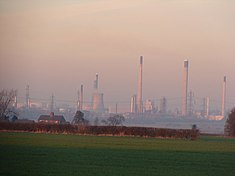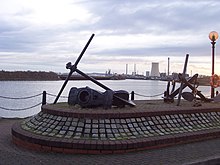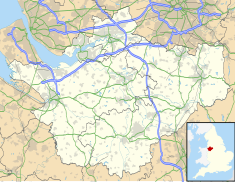Stanlow Oil Refinery
 From Wikipedia the free encyclopedia
From Wikipedia the free encyclopedia
 The Refinery from a distance | |
Location within Cheshire | |
| Country | England, United Kingdom |
|---|---|
| Province | Cheshire, North West England |
| Coordinates | 53°16′22″N 2°50′24″W / 53.27278°N 2.84000°W |
| Refinery details | |
| Operator | Shell UK (1924-2011) Essar Oil UK (2011-present) |
| Owner(s) | Essar Energy (2011-present) |
| Commissioned | 1924 |
| Capacity | 296,000 bbl/d (47,100 m3/d) |
| No. of employees | 960[1] |
Stanlow Refinery is an oil refinery owned by Essar Energy in Ellesmere Port, North West England.[2] Until 2011 it was owned by Shell UK. The refinery is situated on the south bank of the Manchester Ship Canal, which is used to transport seaborne oil for refining and chemicals for Essar and Shell.[3]
Stanlow has a refining capacity of 12 million tonnes per year with a barrel per day capacity of 296,000.[4] Consequently, it is the second largest in the United Kingdom after Fawley Refinery,[5] and produces a sixth of the UK's petrol needs.[6] Stanlow is also a large producer for commodities such as jet fuel and diesel.[7]
Although situated in North West England, the refinery serves much of England as it is linked to the UK oil pipeline network.[8][9] Oil is delivered to the Tranmere Oil Terminal via ship, then pumped to Stanlow for refining and stored for delivery.
History[edit]

The refinery occupies nearly 1,900 acres (7.7 km2) near the River Mersey and dates back to 1924, when a small bitumen plant was established.[10] Stanlow & Thornton railway station was opened in 1940 to give workers access to the site and the facility an extra mode of transport. However, this station is now only served by three trains daily towards each of Ellesmere Port (westbound) and Helsby (eastbound), with these services scheduled to depart at times which would be inconvenient for the workers.
In the 1974 an oil pipeline was commissioned from Amlwch, Anglesey to Stanlow. Crude oil was pumped ashore from tankers moored at deep-water pontoons to a holding station at Rhosgoch, from there it was pumped through two 36-inch diameter pipelines, 127 km to Stanlow. The pipeline had closed by 1990.[11][12]
Crude oil is now received lower down river on the Mersey at the Tranmere Oil Terminal, operated by the Mersey Docks and Harbour Company from its Liverpool headquarters, and is transferred via a fifteen-mile (24 km) pipeline to storage at Stanlow. Output is delivered via various means, including by pipeline via the UK oil pipeline network, road and the Manchester Ship Canal. There is also a pipeline for jet fuel to Manchester Airport.
In 2010, Royal Dutch Shell declared their desire to sell off some refineries in Europe to concentrate on emerging markets in Asia and the Middle East, which led to the possibility that Stanlow would be shut down indefinitely.[13] However, Shell said that a number of refineries in their portfolio offered over-capacity and consequently Stanlow, their last British refinery, was put up for sale.[14]
After a prolonged period of negotiation, Stanlow was sold by Shell to Essar Energy for approximately $1.3 billion (£814 million) in 2011.[1] Essar has stated their desire to expand the site with a 25% increase in output.[15] Following the bankruptcy of Petroplus which ran the Coryton Refinery in January 2012, Essar stated their belief that Stanlow, being a large refinery, would be able to compete with refineries in Asia and the Middle East.[16] Essar plan a £250 million expansion of Stanlow, with production of diesel and aviation fuel to be increased.[17] In April 2021 the company was reported to be heavily in debt after fossil fuel demand dropped during the COVID-19 pandemic.[18] In September 2021 it was reported that the facility is at the "brink of collapse".[19]
Stanlow Island[edit]
Stanlow Island is a small island found on the Manchester Ship Canal outside the Stanlow oil refinery. The island was occupied until the 1990s when the locals left due to isolation and the hazards of living nearby the refinery.[20] Notable structures are the remains of Stanlow Abbey founded in 1178 that remain at Stanlow Point.[21] Access to the island using a 24-hour request ferry that links the Essar refinery to Stanlow Island with special permission.
Protests[edit]
- Stanlow's position as one of the largest and well-known refineries in the country, has led to numerous protests over a number of decades. In the UK fuel crisis of 2000, protests over government taxation on fuel began at Stanlow.[22][23] A large fuel price protest was staged in May 2011 with the objective of "shutting down" the refinery.[24]
- During the 2022 Russian invasion of Ukraine, dockworkers of the Unite union began to refuse to unload Russian oil from any ship.[25] Despite sanctions on Russian shipping, Russian oil continued to arrive at port on ships owned and flagged in other countries. Dockworkers have called this a loophole in sanctions.[26][27][28]
Statistics[edit]

- Storage capacity: 2 million tonnes of crude oil and products [10]
- Refining capacity: 12 million tonnes per year. The manufacturing complex employs 800 people.
- Barrel per day output: 272,000 bbl/d (43,200 m3/d)[29]
- Product output
Cultural references[edit]
- In 1980, electronic band Orchestral Manoeuvres in the Dark (OMD) from nearby Wirral featured a song about the refinery called "Stanlow" on their second album, Organisation.
- Welsh band Jesu's 2007 album Conqueror features a track titled "Stanlow" that concerns itself with the refinery.
Haydock terminal[edit]
| Country | England |
|---|---|
| State | Lancashire |
| City | Haydock |
| Coordinates | 53.47764 N, 2.65983 W |
| Refinery details | |
| Operator | BP and Shell-Mex |
| Owner(s) | BP and Shell-Mex |
| Commissioned | 1969 |
| Decommissioned | 1988 |
| Area | 90 acre |
| Capacity | 22 million gallons (100,000 m3) of white oil and 42 million gallons (191,000 m3) of black oil per year. |
| No. of employees | 260 |
| No. of oil tanks | 30 |
| Oil refining center | No, tank farm and road tanker filling |
In 1969 Shell-Mex & BP opened a £3 million joint venture bulk hydrocarbon liquid distribution centre at Haydock, Lancashire (53.47764 N, 2.65983 W).[30] This was built on a 90-acre (36.4 ha), site although only 20.2 ha were developed in the first stage. The terminal reflected the growing use of oil as an energy source in the development of North West England. The oil supply companies wished to make oil available at appropriate locations and when needed; and to modernise the distribution of oil to improve efficiency. The terminal was designed to store up to 1 million tonnes of oil, making it the largest inland oil depot in Europe. It handled 5,000 tonnes of oil products daily, comprising 22 million gallons (100,000 m3) of white oils and 42 million gallons (191,000 m3) of black oils a year.
The terminal was near the St Helens branch railway from which a branch led to loading and off-loading sidings in the terminal.[31] Heavy oils were delivered by two trains per day from Stanlow, and one daily train from Heysham refinery.[32] The terminal was supplied with light oils via a 41.6 km (150 mm diameter) pipeline from Stanlow refinery. Oil products were loaded into a fleet of 100 road tankers for distribution. Upon arrival at the terminal road tankers were directed automatically to an empty stand where filling took place from an overhead gantry.[30]
The terminal employed 260 staff including 170 drivers working a two shift, six days per week system.[30]
In 1987 Shell undertook a review of the distribution of oil across the UK.[33] It intended to make the most of improved road networks in the country. As a result the company spent £17 million in developing a new distribution network. This included development and rebuilding of the distribution centre adjacent to the Stanlow refinery and at the oil terminal at Shell Haven in Essex. However, the review identified that the Haydock terminal should close.[33] Thirty-two of the tanker drivers based at Haydock were transferred to Stanlow, together with some clerical jobs at Haydock. The Haydock terminal closed in 1988.[34] The site was eventually redeveloped as a commercial estate.
See also[edit]
- Petroleum refining in the United Kingdom
- Tranmere Oil Terminal
- UK oil pipeline network
- Oil terminals in the United Kingdom
References[edit]
- ^ a b "Royal Dutch Shell to sell Stanlow refinery for $1.3bn". BBC News. 29 March 2011. Retrieved 30 March 2012.
- ^ "Profile". Essar Group. Archived from the original on 7 November 2011.
- ^ "Manchester Ship Canal". Peel Ports. Retrieved 25 January 2012.
- ^ "Raring to grow". Essar Energy. 20 August 2011. Retrieved 30 March 2012.
Located near Ellesmere Port in north west England, the Stanlow refinery is the second largest in the UK. With has a nameplate capacity of 296,000 barrels of oil a day, it is responsible for about one sixth of the UK's petrol supply.
- ^ "Essar Energy acquires Shell's Stanlow refinery for $350 mn". Business Standard India. 29 March 2011.
- ^ "Stanlow Manufacturing Complex". Shell. Archived from the original on 13 August 2011. Retrieved 25 January 2012.
- ^ "Stanlow refinery sold for £219m". Manchester Evening News. 18 February 2011. Retrieved 26 January 2012.
- ^ Dowling, Stephen (13 May 2016). "The UK's network of secret fuel pipes that helped win WWII". BBC. Retrieved 18 December 2023.
- ^ Poole, Robert; Wright, Steve (1982). Target North West: Civil Defence & Nuclear War in Cumbria, Lancashire, Manchester, Merseyside & Cheshire (PDF). Richardson Institute for Peace and Conflict Research, University of Lancaster.
- ^ a b Interactive Guide to UK Refineries: Stanlow (Shell), energyinst.org.uk, retrieved 28 August 2007
- ^ Sallery, Dave, The Associated Octel Company and the Amlwch branch, retrieved 1 August 2008
- ^ "Anglesey marine terminal". Amlwch History. Retrieved 8 June 2020.
- ^ Wainwright, Martin (10 August 2009). "Future of oil refinery in doubt as Shell considers sale of Stanlow". The Guardian. Retrieved 31 March 2012.
- ^ Macalister, Terry (4 February 2010). "Shell to axe another 1,000 jobs and sell last UK refinery". The Guardian. Retrieved 30 March 2012.
- ^ Barrett, Jayne (30 March 2011). "New Stanlow refinery boss promises expansion". BBC News. Retrieved 26 January 2012.
- ^ Milmo, Dan (27 February 2012). "Oil refineries likely to close across UK and Europe, Essar Energy boss warns". The Guardian. Retrieved 30 March 2012.
- ^ Hodgson, Neil (7 November 2011). "Essar Energy says Stanlow oil refinery integration in line with expectations". Liverpool Daily Post. Retrieved 1 April 2012.
- ^ Gareth, Simkins (12 April 2021). "Stanlow refinery owner 'nearing collapse'". Ends Report. Haymarket Media Group. Retrieved 12 April 2021.
- ^ Wearden, Graeme (26 September 2021). "Stanlow oil refinery 'on brink of collapse' as crisis talks continue". The Guardian. Retrieved 26 September 2021.
- ^ Hadfield, Charlotte; Houghton, Alistair; Grimsditch, Lee (17 September 2023). "The forbidden island in the River Mersey you need special permission to visit". Manchester Evening News. Retrieved 18 December 2023.
- ^ Houghton, Alistair (1 September 2018). "The secret island in the Mersey with abbey ruins and a 24-hour ferry - Stanlow Island". Liverpool Echo. Retrieved 18 December 2023.
- ^ "Refinery hit by fuel protesters". BBC News. 8 September 2000. Retrieved 1 April 2012.
- ^ "Fuel protest at oil refinery". Manchester Evening News. 2 May 2008. Retrieved 1 April 2012.
- ^ "Fuel protesters' Ellesmere Port oil blockade bid". BBC News. 8 May 2011. Retrieved 1 April 2012.
- ^ Wilkinson, Damon (4 March 2022). "Workers at Stanlow oil refinery refuse to unload cargo of Russian oil on-board German ship". Manchester Evening News. Retrieved 18 December 2023.
- ^ Davies, Rob; Acland, Olivia (5 March 2022). "Dockers at Merseyside refinery refuse to unload Russian oil". The Guardian. Retrieved 18 December 2023.
- ^ "Tanker of Russian gas docks in France after being turned away from UK". Reuters. 5 March 2022.
- ^ "Ukraine: Workers refuse to unload Russian oil from ship". BBC News. 5 March 2022.
- ^ "Shell receives offer for Stanlow refinery in the UK". Shell UK. 18 February 2011. Retrieved 26 January 2012.
- ^ a b c "Europe's biggest oil depot opened at Haydock". commercial motor. 1969. Retrieved 9 September 2020.
- ^ "oil terminals no more..." Retrieved 7 December 2023.
- ^ Sinha, Shatrughna (1993). Instant Encyclopaedia of Geography, volume 23. New Delhi: Mittal Publications. pp. 260–1. ISBN 9788170994831.
- ^ a b "Shelling out to oil the wheels at Stanlow". Liverpool Echo. 29 May 1987.
- ^ "Shell look to the future". Liverpool Echo. 31 December 1988. p. 12.
Further reading[edit]
- Shannon, Paul (11–24 March 1998). "End of an era for Stanlow oil". Rail. No. 326. EMAP Apex Publications. pp. 32–36. ISSN 0953-4563. OCLC 49953699.
External links[edit]
- Stanlow United Website of the Stanlow unionised workforce.
